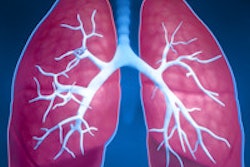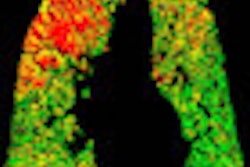Patients with chronic obstructive pulmonary disease (COPD) may carry a high enough risk for lung cancer to qualify them along with middle-aged smokers for annual low-dose CT lung cancer screenings -- even though they aren't covered under recently released guidelines.
Several papers presented at last month's American Thoracic Society (ATS) meeting in San Francisco explored whether individuals with COPD would be suitable for CT lung screening. Such patients weren't included in guidelines released by the American College of Chest Physicians (ACCP) and other societies in May, which only recommended screening for current and former smokers between the ages of 55 and 74 who smoked for 30 pack-years or more.
But at the ATS show, researchers presented evidence indicating that COPD patients have a high enough risk for lung cancer to justify routine screening. They argued that including COPD patients would boost the cancer detection rate for CT screening as found in studies such as the National Lung Screening Trial (NLST). NLST showed a mortality benefit of 20% for CT screening.
Dr. Robert Young, PhD, from the University of Auckland in New Zealand, presented epidemiological research indicating that including COPD patients would increase the absolute yield of confirmed lung cancer cases by 50%.
Young's calculations were based on a retrospective review of two other large randomized clinical trials for CT lung screening. The Pittsburgh Lung Screening Study is a single-center trial involving more than 3,400 smokers and former smokers between the ages of 50 and 79. The Nederlands-Leuvens Longkanker Screenings Onderzoek (NELSON) trial is a Dutch study involving 16,000 people randomized to receive or not receive CT screenings.
The analysis revealed that approximately 40% of CT screening participants already had COPD based on spirometric criteria, from GOLD-1 to GOLD-4. (Global Initiative for Chronic Obstructive Lung Disease [GOLD] staging is used to classify COPD patients according to airflow obstruction.) About 28% had CT-based evidence of emphysema, and 36% to 48% had either one or both diseases.
For those diagnosed with lung cancer, 68% had COPD and another 17% had emphysema, he said.
The data led Young to believe that lung function, possibly measured as a pretest for CT with spirometry, could be an important indicator of lung cancer risk, along with the patient's age and smoking history.
"COPD is a very good marker," he said. "Overall, we are looking at a fourfold difference compared to NLST results. The fourfold increase has been identified in other trials as well."
In another study presented at the ATS conference, Dr. Jeannette Guziel and colleagues from Temple University Medical School established a correlation between increasing COPD severity and increasing probability of a positive CT scan for a possible lung malignancy. They based this conclusion on their evaluation of 10,279 patients from the COPDGene Study, a massive research project investigating the genetic factors that lead to COPD.
Guziel identified 3,761 COPD patients (36%) who met the NLST's inclusion criteria for lung screening. A retrospective review of the most recent chest CT exams for this group revealed that 455 (12.1%) were positive for suspicious pulmonary abnormalities requiring further testing. In comparison, abnormalities were identified in 27% of the first round of exams in the NLST.
The probability of a positive low-dose CT screening scan among COPDGene subjects related to their health status. Those with positive results were generally sicker, older, had more pack-years of smoking experience, were less able to walk short distances, and had a higher prevalence of emphysema than trial participants with negative CT studies, Guziel said.
In a third study, led by Dr. Juan de Torres from the University Clinic of Navarra, mild-to-moderate COPD cases were preferred for screening.
His insights into COPD and cancer risk were drawn from a five-year observational study of 2,507 COPD patients published last year (American Journal of Respiratory and Critical Care Medicine, October 15, 2011, Vol. 184:8, pp. 913-919).
During that time, 215 (8.6%) individuals developed lung cancer. The highest rates arose among older patients with relatively mild airflow obstructions and lower body mass indexes than patients who remained cancer-free.
At the ATS meeting, de Torres presented findings demonstrating the clinical impact of serial CT screening of a randomly selected subgroup of 735 patients with mild-to-moderate COPD, drawn from the larger trial. Their clinical experience was compared to that of 410 similar patients who did not receive low-dose CT screening.
The researchers found that stage I lung cancers represented 95% (32/33) of the pulmonary malignancies diagnosed with five annual CT screenings. Meanwhile, all lung cancers (72/72) diagnosed among patients who were not screened were stage III-IV disease (p < 0.001).
The mortality rate for mild-to-moderate COPD patients who underwent annual CT screening was 0.07 per 100 persons, compared with 1.3 for the control group.
"Smokers and former smokers with COPD have the risk of developing lung cancer," de Torres said."Screening patients at this stage of COPD leads to the diagnosis of lung cancer at an early stage and would reduce mortality from lung cancer for this population."



















